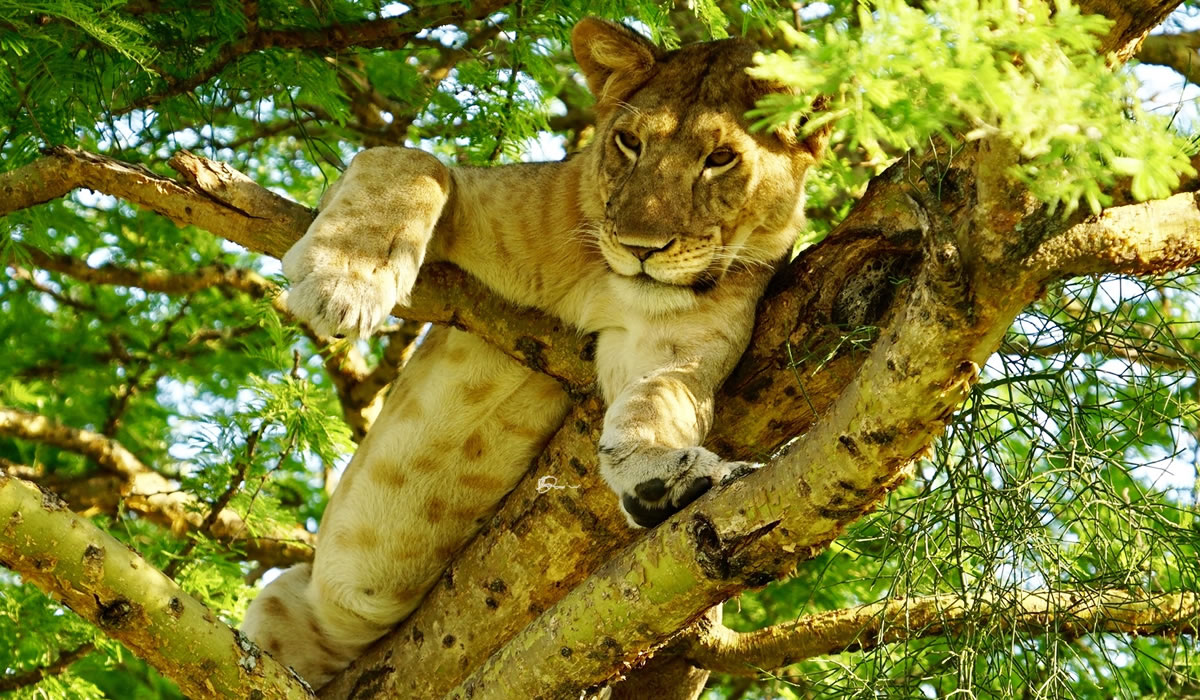Queen Elizabeth National Park is Uganda’s most popular safari destination, famous for its diverse wildlife, breathtaking scenery, and unique ecosystems. Located in western Uganda, stretching across the districts of Kasese, Rubirizi, Rukungiri, and Kamwenge, the park covers about 1,978 square kilometers. It lies within the Albertine Rift Valley, bordered by the snowcapped Rwenzori Mountains in the north and Lake Edward and Lake George in the south. Established in 1952 and named after Queen Elizabeth II during her visit in 1954, the park has since grown into one of the most visited attractions in East Africa, offering unforgettable wildlife encounters, birdwatching, boat cruises, cultural experiences, and scenic landscapes.

The park is home to more than 95 mammal species and over 600 bird species, making it one of the most biodiverse reserves on the continent. Its habitats are varied, ranging from savannah grasslands and acacia woodlands to volcanic craters, swamps, and dense forests. This mosaic of ecosystems provides sanctuary to large populations of elephants, buffaloes, hippos, crocodiles, lions, and leopards, as well as chimpanzees and a dazzling array of birdlife. Queen Elizabeth National Park is also renowned for its tree-climbing lions in the Ishasha sector, a rare phenomenon that attracts safari enthusiasts from around the world.
Game drives are one of the highlights of a visit to Queen Elizabeth National Park. The Kasenyi Plains in the northeastern sector are ideal for spotting herds of Uganda kobs, often followed by lions in search of prey. Elephants, buffaloes, and warthogs are also common sightings, while leopards lurk in the thickets and occasionally make dramatic appearances. Morning and evening game drives provide the best opportunities to observe predators and grazers, with the golden light of sunrise and sunset adding to the spectacle. For travelers who want to explore further, the Ishasha sector in the south offers a unique safari experience, where lions are often seen resting in the branches of fig trees, an iconic sight rarely found in other parks.
A boat cruise along the Kazinga Channel is another must-do activity. This natural waterway connects Lake George to Lake Edward and is one of the most wildlife-rich areas of the park. The two-hour launch trip offers close encounters with large pods of hippos, basking crocodiles, and elephants cooling off at the water’s edge. Birdwatchers will also delight in the variety of species found along the channel, including African fish eagles, pied kingfishers, great cormorants, and saddle-billed storks. The Kazinga Channel boat cruise is particularly rewarding in the afternoon when wildlife gathers along the shores, making it one of the best places in Africa to view animals from the water.
Chimpanzee tracking in Kyambura Gorge provides a different kind of adventure. This dramatic “Valley of Apes” cuts through the savannah to reveal a lush underground rainforest teeming with life. Guided treks take visitors into the gorge to search for chimpanzees, which live alongside black-and-white colobus monkeys, red-tailed monkeys, and various bird species. While sightings are not always guaranteed, the experience of exploring the gorge’s unique ecosystem is thrilling on its own. Another excellent location for primate viewing within the park is the Maramagambo Forest, which is home to baboons, monkeys, and a variety of birds, as well as the famous bat caves.
For birding enthusiasts, Queen Elizabeth National Park is a true paradise. With over 600 recorded species, it is recognized as one of the top birding destinations in East Africa. Key habitats include the Kasenyi Plains, Kazinga Channel, Katunguru Bridge, and the crater lakes. Birders can spot species such as the African skimmer, pink-backed pelican, martial eagle, and the rare shoebill stork. The park’s diversity ensures year-round birding opportunities, with migratory species adding to the excitement between November and April.
The park is also rich in geological and scenic features. The Katwe Explosion Craters, formed by ancient volcanic activity, offer striking landscapes of crater lakes, grasslands, and salt pans. Lake Katwe itself has been used for traditional salt mining for centuries, and visitors can learn about the process from local communities. The panoramic views from the crater rims are breathtaking, stretching across the savannah and beyond to the Rwenzori Mountains. Another striking area is the Mweya Peninsula, a scenic hub surrounded by the Kazinga Channel and Lake Edward, where Mweya Safari Lodge is located. The peninsula offers excellent game viewing opportunities and stunning photographic vistas.
Cultural encounters with local communities add depth to a visit to Queen Elizabeth National Park. The surrounding areas are home to the Banyankole, Bakonzo, and Basongora people, among others. Visitors can take part in cultural tours that showcase traditional dances, storytelling, and crafts. The Katwe salt mining community offers guided tours of their historic salt lake, while the Kikorongo Women’s Community demonstrates traditional skills and performs cultural dances. These experiences not only enrich the visitor’s safari but also provide vital income to local families, strengthening the link between tourism and conservation.
Accommodation in and around Queen Elizabeth National Park caters to all types of travelers. Luxury lodges such as Mweya Safari Lodge, Kyambura Gorge Lodge, and Ishasha Wilderness Camp offer comfort, fine dining, and spectacular views. Midrange options like Enganzi Lodge and Ihamba Safari Lodge provide quality stays with excellent service, while budget travelers can choose from community-run campsites and affordable lodges near the park gates. Staying within or close to the park ensures easy access to game drives, boat cruises, and other activities.
The park is accessible by both road and air. By road, it is about 400 kilometers from Kampala, a journey that takes 6 to 7 hours, passing through scenic countryside and towns such as Mbarara and Fort Portal. Alternatively, chartered flights can be arranged to airstrips at Mweya, Kasese, or Ishasha, significantly reducing travel time and offering aerial views of the Rift Valley.
The best time to visit Queen Elizabeth National Park is during the dry seasons, from June to September and December to February. During these months, wildlife is easier to spot as animals congregate near water sources, and roads are more passable for game drives. The wet seasons from March to May and October to November bring lush green landscapes and excellent birding opportunities, although game drives may be more challenging due to muddy conditions.
Conservation is a key focus in Queen Elizabeth National Park. The Uganda Wildlife Authority works with local communities and international partners to protect the park’s ecosystems and wildlife. Revenue-sharing programs ensure that nearby communities benefit from tourism, reducing conflicts and encouraging cooperation in conservation efforts. The park also plays an important role in ecological balance, acting as a water catchment and supporting biodiversity in the greater Albertine Rift Valley.
Queen Elizabeth National Park is more than just Uganda’s most visited park, it is a destination where wildlife, culture, and landscapes come together in perfect harmony. From the roar of lions on the Kasenyi Plains to the peaceful glide of a boat along the Kazinga Channel, every experience is rich with wonder. Its accessibility, wide range of activities, and exceptional biodiversity make it ideal for both first-time safari travelers and seasoned adventurers.
In conclusion, Queen Elizabeth National Park stands as a jewel in Uganda’s tourism crown. Its combination of classic savannah safaris, boat cruises, primate tracking, birdwatching, cultural encounters, and geological wonders ensures that every visitor leaves with unforgettable memories. Whether you are searching for tree-climbing lions, marveling at elephants on the riverbanks, or soaking in the views of the crater lakes, this park offers an authentic African safari that captures the very essence of Uganda’s natural beauty.
